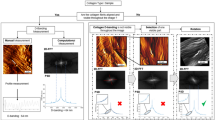Abstract
The method of atomic force microscopy (AFM) is used for the first time for morphological investigation of pathological changes in the extracellular matrix of skin connective tissue upon the prolapse of pelvic organs (common disorder among women). Skin samples of patients with clinically proven pelvic-organ prolapse and of patients that do not have any connective tissue related disease (control group) are investigated via AFM. The AFM study reveals that the extracellular matrix of the skin connective tissues from patients with pelvic-organ prolapse diverges from the normal in various organization levels including both micro- and nanotexture (packing of collagen fibers and fibrils, respectively). The results of AFM study of the normal and pathologically changed skin connective tissues are in good agreement with the data of clinical morphological analysis, which indicates the potential of AFM as an independent diagnostic tool.
Similar content being viewed by others
References
M. H. Kerkhof, L. Hendriks, and H. A. M. Brölmann, Int. Urogynecol. J. 20, 461 (2009).
S. N. Buyanova, N. A. Shchukina, and A. S. Zhuravleva, Ross. Vestn. Akushera-Ginekol., No. 1, 76 (2009).
A. R. Smith, Curr. Opin. Obstet. Gynecol. 6, 317 (1994).
M. E. Carley and J. Schaffer, Am. J. Obstet. Gynecol. 182, 1021 (2000).
T. Smol’nova and L. V. Adamyan, Kuban. Nauch. Med. Vestn., No. 6, 69 (2009).
J. P. R. O. Orgel, T. C. Irving, A. Miller, and T. J. Wess, Proc. Natl. Acad. Sci. USA 103, 9001 (2006).
M. H. Flint and M. J. Merrilees, Histochem. J. 9, 1 (1977).
I. Casuso, F. Rico, and S. Scheuring, J. Mol. Recogn. 24, 406 (2011).
M. Lekka, P. Laidler, D. Gil, et al., Eur. Biophys. J. 28, 312 (1999).
G. Y. H. Lee and C. T. Lim, Trends Biotechnol. 25, 111 (2007).
S. E. Cross, Y.-Sh. Jin, J. Tondre, et al., Nanotecnology 19, 384003 (2008).
K. Schilcher, R. Silye, and H.-P. Huber, J. Adv. Microsc. Res. 5, 86 (2010).
X. Xing, H. Jin, Y. Lu, et al., Micron 42, 42 (2011).
H. K. Graham, N. W. Hodson, J. A. Hoyland, et al., Matrix Biol. 29, 254 (2010).
V. V. Zharov, A. N. Lyalin, O. V. Karban’, et al., J. Surf. Invest.: X-Ray, Synchrotron Neutron Tech. 3, 804 (2009).
M. Stolz, R. Gottardi, R. Raiteri, et al., Nature Nanotechnol. 4, 186 (2009).
I. Sridharan, Y. Ma, T. Kim, et al., Biomaterials 33, 1520 (2012).
Author information
Authors and Affiliations
Corresponding author
Additional information
Original Russian Text © S.L. Kotova, A.B. Shekhter, P.S. Timashev, A.E. Guller, A.A. Mudrov, V.A. Timofeeva, V.Ya. Panchenko, V.N. Bagratashvili, A.B. Solovieva, 2014, published in Poverkhnost’. Rentgenovskie, Sinkhrotronnye i Neitronnye Issledovaniya, 2014, No. 8, pp. 24–31.
Rights and permissions
About this article
Cite this article
Kotova, S.L., Shekhter, A.B., Timashev, P.S. et al. AFM study of the extracellular connective tissue matrix in patients with pelvic organ prolapse. J. Surf. Investig. 8, 754–760 (2014). https://doi.org/10.1134/S1027451014040260
Received:
Published:
Issue Date:
DOI: https://doi.org/10.1134/S1027451014040260




